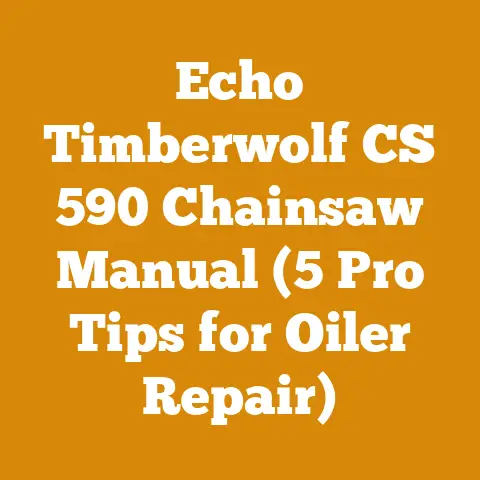Trailer for Firewood (5 Expert Tips for Efficient Hauling)
Ever wondered how to transform a pile of freshly cut logs into a neatly stacked, efficiently hauled load of firewood? It’s more than just tossing wood into a trailer; it’s about strategy, safety, and maximizing every trip. I’ve spent years wrestling with logs, from my early days splitting wood with a maul to now, managing larger-scale firewood operations. Over time, I have learned some hard lessons, like the time my overloaded trailer nearly jackknifed on a steep hill. Trust me, those experiences are etched in my memory.
This guide is designed to share my hard-earned knowledge, focusing on five expert tips that will streamline your firewood hauling process, whether you’re a weekend hobbyist or a seasoned pro. We will dive deep into the technical aspects, from understanding wood density to optimizing trailer load distribution.
1. Selecting the Right Trailer: Size, Capacity, and Features
Choosing the right trailer is the foundation of efficient firewood hauling. It’s not just about grabbing the first trailer you see; it’s about matching the trailer to your specific needs. I remember when I first started, I used an old utility trailer that was way too small. I ended up making countless trips, wasting time and fuel.
Understanding Trailer Types
- Utility Trailers: These are the workhorses of the trailer world, versatile for hauling various materials. They typically have low sides or no sides, making loading and unloading firewood relatively easy.
- Box Trailers (Enclosed Trailers): While offering protection from the elements, box trailers can be cumbersome for firewood. The enclosed space limits airflow, which is crucial for drying firewood, and loading/unloading can be a pain.
- Dump Trailers: Ideal for large-scale firewood operations. The hydraulic dump feature saves significant time and labor. I’ve used dump trailers on several occasions, and the time savings alone paid for the rental.
- Log Trailers: Specifically designed for hauling logs, these trailers often feature bunks and stakes to secure the load. While overkill for most firewood hauling, they’re essential for raw log transport.
Calculating Load Capacity
Understanding load capacity is critical for safety and efficiency. Overloading a trailer can lead to dangerous situations, including tire blowouts, brake failure, and even trailer damage.
- Gross Vehicle Weight Rating (GVWR): This is the maximum permissible weight of the trailer and its cargo. You’ll find this rating on a sticker on the trailer frame.
- Curb Weight: The weight of the empty trailer.
- Payload Capacity: The difference between the GVWR and the curb weight. This is the maximum weight of firewood you can legally haul.
Example: A trailer with a GVWR of 3,500 lbs and a curb weight of 1,000 lbs has a payload capacity of 2,500 lbs.
Wood Density and Weight Calculation
Different types of wood have different densities, which directly impacts the weight of your load. Knowing the density of the wood you’re hauling is crucial for accurate weight calculations.
- Hardwoods: Generally denser than softwoods. Examples include oak, maple, and ash.
- Softwoods: Less dense than hardwoods. Examples include pine, fir, and spruce.
Typical Wood Densities (at 20% moisture content):
| Wood Type | Density (lbs/cubic foot) |
|---|---|
| Oak | 45-55 |
| Maple | 35-45 |
| Ash | 35-45 |
| Pine | 25-35 |
| Fir | 20-30 |
Calculating the Weight of a Cord of Wood:
A standard cord of wood measures 4 feet high, 4 feet wide, and 8 feet long (128 cubic feet). However, due to air gaps between the logs, a cord of wood typically occupies about 85 cubic feet of solid wood.
Example: A cord of oak (density 50 lbs/cubic foot) weighs approximately 4,250 lbs (85 cubic feet x 50 lbs/cubic foot).
Important Considerations:
- Moisture Content: Freshly cut wood can weigh significantly more due to its high moisture content. Aim for firewood with a moisture content of 20% or less for optimal burning. I use a moisture meter religiously to ensure my firewood is properly seasoned.
- Axle Rating: The trailer’s axle rating must be sufficient to support the load. Ensure that the combined weight of the trailer and cargo does not exceed the axle rating.
- Tire Rating: Similar to the axle rating, the tires must be rated to handle the load. Check the sidewall of the tires for the maximum load capacity.
Trailer Features
- Ramps: Essential for loading larger logs or equipment onto the trailer.
- Tie-Down Points: Secure the firewood to prevent shifting during transport. I prefer trailers with multiple tie-down points along the sides and corners.
- Brakes: Trailers with a GVWR over a certain weight (typically 3,000 lbs) are often required to have brakes. Electric brakes are common and offer good stopping power.
- Lights: Ensure all lights are functioning properly for safe towing, especially at night.
My Personal Experience
I once underestimated the weight of a load of green oak. I figured my trailer could handle it, but I was wrong. The trailer tires were visibly sagging, and the handling was terrible. I had to offload a significant portion of the wood before I could safely continue. This taught me a valuable lesson about the importance of accurate weight calculations and respecting load limits.
Technical Requirements
- Trailer GVWR: Must be clearly displayed on the trailer frame.
- Axle Rating: Must be sufficient for the intended load.
- Tire Rating: Must meet or exceed the load requirements.
- Brake Requirements: Comply with local regulations regarding trailer brakes.
- Lighting Requirements: Ensure all lights meet DOT standards.
2. Efficient Loading Techniques: Maximizing Space and Stability
How you load your trailer is just as important as the trailer itself. A poorly loaded trailer can be unstable, difficult to handle, and even dangerous.
Layering and Stacking
- Base Layer: Start with a solid, even base layer of firewood. This provides a stable foundation for the rest of the load. I like to use larger, flatter pieces for the base layer.
- Stacking Pattern: Use a consistent stacking pattern to maximize space and stability. Crisscrossing the logs can help to interlock them and prevent shifting.
- Filling Gaps: Fill any gaps between the logs with smaller pieces of firewood. This helps to create a more compact and stable load.
Weight Distribution
- Center of Gravity: Keep the center of gravity as low as possible. This improves stability and reduces the risk of tipping.
- Front-to-Back Distribution: Distribute the weight evenly from front to back. Too much weight in the front can cause the trailer to sway, while too much weight in the back can cause the trailer to fishtail.
- Side-to-Side Distribution: Distribute the weight evenly from side to side. Uneven weight distribution can cause the trailer to lean to one side, making it difficult to control.
Securing the Load
- Tie-Down Straps: Use heavy-duty tie-down straps to secure the firewood to the trailer. Ratchet straps are ideal for tightening and securing the load.
- Netting: Use a cargo net to cover the firewood and prevent loose pieces from falling off the trailer.
- Chains: For very heavy loads, consider using chains in addition to straps.
Practical Tips
- Start with the Largest Logs: Place the largest logs in the base layer and work your way up to the smaller pieces.
- Alternate Log Orientation: Alternate the orientation of the logs in each layer to create a more stable load.
- Use Wedges: Use wedges to fill gaps and prevent logs from rolling.
- Check the Load Regularly: Stop periodically to check the load and tighten the straps as needed.
Case Study: Optimizing Load Distribution
I once worked on a project where we were hauling large quantities of firewood over long distances. We experimented with different loading techniques and found that a specific stacking pattern significantly improved stability and reduced the risk of load shifting.
The Stacking Pattern:
- Base Layer: Large, flat logs placed horizontally across the trailer bed.
- Second Layer: Logs placed perpendicular to the base layer, crisscrossing to interlock them.
- Third Layer: Logs placed parallel to the base layer, but offset to fill any gaps.
- Repeat: Continue alternating layers, ensuring that each layer is tightly packed and secured with straps.
This stacking pattern, combined with proper weight distribution, allowed us to haul larger loads more safely and efficiently.
Technical Specifications
- Tie-Down Strap Rating: Must be rated to handle the weight of the load.
- Netting Material: Heavy-duty nylon or polyester netting recommended.
- Strapping Technique: Ensure straps are properly tensioned and secured to the trailer frame.
- Load Securement Standards: Comply with local and national regulations regarding load securement.
3. Tire Maintenance and Safety: Ensuring a Smooth Ride
Your trailer tires are the only things between you and the road. Proper tire maintenance is crucial for safety, fuel efficiency, and preventing costly breakdowns.
Tire Pressure
- Check Regularly: Check the tire pressure before each trip. Use a reliable tire pressure gauge.
- Recommended Pressure: Consult the tire sidewall or the trailer manufacturer for the recommended tire pressure.
- Adjust for Load: Adjust the tire pressure based on the load. Heavier loads require higher tire pressures.
Tire Condition
- Inspect for Damage: Inspect the tires for cuts, bulges, and other damage. Replace damaged tires immediately.
- Tread Depth: Check the tread depth regularly. Tires with insufficient tread depth are more prone to hydroplaning and loss of traction.
- Age of Tires: Tires degrade over time, even if they’re not used. Check the date code on the tire sidewall and replace tires that are more than six years old.
Tire Rotation
- Rotate Regularly: Rotate the tires regularly to ensure even wear. Consult the trailer manufacturer for the recommended rotation pattern.
Spare Tire
- Carry a Spare: Always carry a spare tire in good condition.
- Tools: Ensure you have the necessary tools to change a tire, including a jack, lug wrench, and torque wrench.
Safety Precautions
- Overloading: Never overload the tires. Exceeding the maximum load capacity can lead to tire failure.
- Speed: Avoid excessive speed. High speeds can cause tires to overheat and fail.
- Road Hazards: Be aware of road hazards, such as potholes and debris, which can damage tires.
My Personal Experience
I once experienced a tire blowout on a remote logging road. I was miles from the nearest town, and it was getting dark. Fortunately, I had a spare tire and the necessary tools. It took me a while, but I was able to change the tire and get back on the road. This experience reinforced the importance of carrying a spare tire and knowing how to change it.
Technical Specifications
- Tire Pressure Gauge Accuracy: +/- 1 PSI
- Minimum Tread Depth: 2/32 inch (1.6 mm)
- Tire Date Code: Located on the tire sidewall (e.g., “1223” indicates the 12th week of 2023).
- Torque Wrench Setting: Consult the trailer manufacturer for the recommended lug nut torque.
4. Hitching and Towing: Connecting and Moving Safely
The connection between your tow vehicle and the trailer is critical for safe towing. A properly hitched and maintained connection ensures smooth handling and prevents accidents.
Hitch Types
- Ball Hitch: The most common type of hitch. A ball-shaped hitch ball is mounted on the tow vehicle, and the trailer coupler attaches to the ball.
- Pintle Hitch: Used for heavier loads. A pintle hook is mounted on the tow vehicle, and the trailer has a lunette eye that attaches to the hook.
- Gooseneck Hitch: Used for very heavy loads. A ball is mounted in the bed of the tow vehicle, and the trailer has a gooseneck coupler that attaches to the ball.
Hitch Capacity
- Match the Hitch to the Load: Ensure that the hitch is rated to handle the weight of the trailer and its cargo.
- Exceeding Capacity: Never exceed the hitch’s maximum weight capacity.
Hitch Maintenance
- Inspect Regularly: Inspect the hitch for cracks, rust, and other damage.
- Lubricate: Lubricate the hitch ball regularly to reduce friction and wear.
- Tighten Bolts: Check and tighten all bolts regularly.
Towing Safety
- Driving Speed: Maintain a safe driving speed. Reduce speed in adverse weather conditions.
- Following Distance: Increase following distance to allow for increased stopping distance.
- Turning: Make wide turns to avoid hitting curbs or other obstacles.
- Braking: Brake smoothly and gradually. Avoid sudden braking, which can cause the trailer to sway.
- Mirrors: Use extended mirrors to improve visibility.
My Personal Experience
I once witnessed a trailer come unhitched from a tow vehicle on a busy highway. The trailer swerved wildly before crashing into a guardrail. Fortunately, no one was injured, but the incident could have been much worse. This experience highlighted the importance of proper hitching and regular maintenance.
Technical Requirements
- Hitch Rating: Must be clearly displayed on the hitch.
- Ball Size: Must match the trailer coupler size.
- Safety Chains: Must be properly attached and crossed under the trailer tongue.
- Lighting Connections: Ensure all lighting connections are secure and functioning properly.
- Brake Controller: If the trailer has electric brakes, a brake controller is required in the tow vehicle.
5. Understanding Firewood Regulations: Ensuring Compliance
Firewood regulations vary by state and even by county. Understanding and complying with these regulations is crucial to avoid fines and penalties.
Quarantine Zones
- Invasive Species: Many areas have quarantine zones to prevent the spread of invasive species, such as the emerald ash borer and the Asian longhorned beetle.
- Restrictions: Quarantine zones may restrict the movement of firewood from one area to another.
- Local Laws: Always check local regulations before transporting firewood.
Moisture Content Regulations
- Seasoned Firewood: Some areas require firewood to be properly seasoned (dried) before it can be sold or transported.
- Moisture Content Limits: Moisture content limits may be specified in local regulations.
Measurement Regulations
- Cord Measurement: The standard unit of measurement for firewood is the cord, which is 128 cubic feet.
- Accurate Measurement: Ensure that firewood is accurately measured when selling or transporting it.
Permits and Licenses
- Commercial Operations: Commercial firewood operations may require permits and licenses.
- Check Requirements: Check with local authorities to determine the permit and license requirements in your area.
Best Practices
- Buy Local: Buy firewood from local sources to reduce the risk of spreading invasive species.
- Burn Local: Burn firewood near where it was harvested.
- Season Firewood: Season firewood properly before burning it.
- Comply with Regulations: Comply with all local and state regulations regarding firewood.
My Personal Experience
I once received a warning from a state forestry official for transporting firewood across a quarantine zone. I was unaware of the regulations at the time, but I quickly learned my lesson. Since then, I’ve always made sure to check local regulations before transporting firewood.
Technical Information
- Moisture Content Measurement: Use a moisture meter to accurately measure the moisture content of firewood.
- Cord Volume Calculation: Ensure that firewood is stacked tightly and accurately measured to determine the cord volume.
- Quarantine Zone Maps: Consult state and local forestry agencies for quarantine zone maps and regulations.
- Firewood Regulations: Review the USDA firewood map.
By following these five expert tips, you can haul firewood more efficiently, safely, and legally. Remember, preparation and knowledge are key to success in any firewood operation. And who knows, maybe you’ll even avoid a near jackknife experience like I did! Happy hauling!






